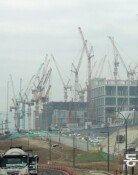Success of Foreign Corporations Korean R&D centers
Success of Foreign Corporations Korean R&D centers
Posted August. 04, 2002 23:18,
▽ Evaluation of Korean technological capability = When the U.S. OTIS Inc. acquired elevator subsidiary of LG Electronics Ltd in 1999, there was a rumor of OTIS shutting down the Korean elevator R&D center. OTIS has four other research centers in U.S., Germany, Spain and Japan. They already had a technology distribution system to their global branch from these existing research centers. Therefore if they were to shut down the Korean R&D center, they would save expanse of several tens of billion won every year. OTIS even made up an internal report that states Korean technology would be obsolete in the global theater.
However when OTIS reevaluated the organization right after the acquisition, theyve found substantial high technology level already accumulated from Korean R&D center. In the end, they decided to maintain the R&D center.
Later LG OTIS has developed an accident prevention door system and vibration reducing guide roller that allows comfortable ride. Theyve developed these high technologies and began to export it to U.S. and Europe.
OTIS has designated the Korean R&D center as their fifth global R&D center in last November. Every year they provide R&D budget of hundred billion won, explained Seo Jong-ho, Director of LG OTIS R&D center.
▽ Modernization of R&D process. = In July 1988, the Swedish Volvo Corp. has acquired Samsung Heavy Machinery (Ltd.)s machinery business subsidiary and incorporated to Volvo Construction machinery Korea Ltd. After the incorporation, they began to change the existing process of its R&D center. They made a several levels of strict evaluating process to determine the necessity of particular technology R&D in which only the profitable technologies could be researched.
In order to begin a R&D project, the center has to submit a report of project validity to headquarter management. After beginning the project, they have to obtain another approval of the headquarter board of directors with a detailed R&D plan. When a prototype is developed, they must compromise with the global branch offices experts in marketing, after service and etc. Before they begin production, they must obtained a final approval from the headquarter board of directors. The new decision making process is two to three months longer than before but now only the profitable technologies are researched.
In the past, technologies were researched by impromptu of the center and management without proper consideration of market and production. Those technologies were mainly unprofitable and left unused, said Jin Jong-eon, managing director of R&D center.
▽ Relocation of main R&D center to Korea = Honeywell Corp. is the worlds No. 1 company in automatic control system of aerodynamics, automobile and buildings. Theyve relocated their R&D center from Minneapolis, U.S. to Korea in last January because Korea has bountiful high skilled labor and excellent R&D infrastructure.
Annual stipend of Koreas highly skilled labor range from $35,000 to 40,000, which is about 70% of equivalent labor in Europe and U.S. Labor cost is cheaper but their R&D capability is not inferior to developed countries, said Lee Seung-sin, managing director of this company.
Good IT infrastructure and high quality of colleges and research institutes also became vital factors for relocation of Honeywells R&D center.
Other American corporations are also watching the relocation of Honeywells R&D center with interest. With the outcome of the Honeywell R&D center, they could be other corporations relocating their R&D center to Korea, added Director Lee.
The problem is that we cant be certain Korea is the final destination of multi national corporations R&D centers.
If multi-national corporations relocate their R&D center to Korea, there is no reason for them to relocate themselves to China where labor cost is even cheaper. In order to maintain technological superiority, there should be a joint effort of government and private sectors, said Jung Kap-geun, Managing Director of Motorola Korea Ltd.
Chi-Young Shin Chang-Won Kim higgledy@donga.com changkim@donga.com







